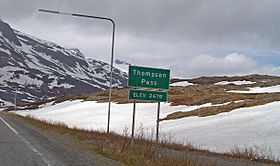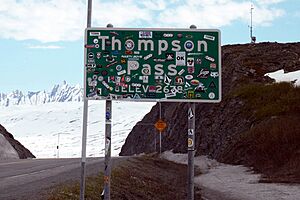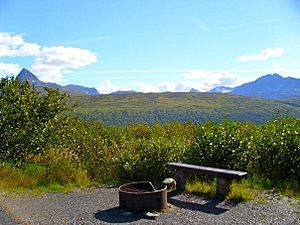Thompson Pass facts for kids
Quick facts for kids Thompson Pass |
|
|---|---|

Thompson Pass, as seen in May 2009.
|
|
| Elevation | 2,805 ft (855 m) |
| Traversed by | Richardson Highway, Trans-Alaska Pipeline System |
| Location | Valdez-Cordova Census Area, Alaska, United States |
| Range | Chugach Mountains |
| Coordinates | 61°07′43″N 145°43′47″W / 61.12861°N 145.72972°W |
Thompson Pass is a mountain pass located in the Chugach Mountains of Alaska. It sits northeast of Valdez, Alaska and is about 2,805 feet (855 meters) high. This pass is famous for being the snowiest place in Alaska.
On average, Thompson Pass gets about 500 inches (1,270 cm) of snow every year! The most snow ever recorded in one season in Alaska fell here during the winter of 1952–1953. A huge 974.1 inches (2,474 cm) of snow covered the pass that year. This is also the most snow ever recorded in one season anywhere in the United States. Thompson Pass also holds the Alaska record for the most snow in a single day: 62 inches (157 cm) fell on December 29, 1955.
The pass was named in 1899 by a U.S. Army captain named William Abercrombie. He named it after Frank Thomson from Pennsylvania. However, he spelled the name "Thompson" on his map, and that spelling has been used ever since.
Contents
Early Trails and Roads
Long before Captain Abercrombie arrived, Alaska Native Ahtna people used the pass for travel. Abercrombie later marked a trail through the pass. This trail was used by miners during the Klondike Gold Rush. It became known as the Valdez-Eagle Trail.
Later, the Washington-Alaska Military Cable and Telegraph System used this path. They strung communication cables through Thompson Pass. The trail was improved over time, and in 1913, cars were able to drive its entire length. By then, it was called the Valdez-Fairbanks Trail. In 1919, it was renamed the Richardson Road.
Because of the very heavy snowfall, the Richardson Highway through Thompson Pass was only used in the summer. But in 1950, a freight company foreman showed that the pass could be kept open all year. He used snowplows to clear the snow. The road remained gravel until 1955, when it was finally paved.
Building the Alaska Pipeline
In the early 1970s, Thompson Pass was a very busy place. Thousands of workers were building a part of the Trans-Alaska Pipeline System here. A large work camp was set up nearby. The heavy snowfall in the pass made working in winter very difficult. However, the pipeline was finished by 1977. Today, oil flows through the pass almost all the time.
Valdez, Alaska is where the pipeline ends in the south. Thompson Pass is the only way to get to Valdez by land. Because of this, the state of Alaska has a special road service station in the pass. This station works to keep the road plowed and free of ice all year. The facility also includes a small landing strip called Thompson Pass Airport. State aircraft use this strip. Keeping the highway clear is a huge challenge due to the extreme weather. This difficult work was shown in the Discovery Channel TV special Alaska: Most Extreme.
Fun Activities at Thompson Pass
Thompson Pass is a popular spot for visitors and people who love adventure. Many people come here for heliskiing and snowboarding. These are popular activities because of the deep snow and beautiful mountains.
Special Parks and Sites
Blueberry Lake State Recreation Site
Blueberry Lake State Recreation Site is a 192-acre (78 ha) park located in Thompson Pass. It has a lake where you can find Arctic grayling fish. The park also has a campground and several picnic areas. Many people say it is one of Alaska’s most beautiful campgrounds.
Worthington Glacier State Recreation Site
Worthington Glacier State Recreation Site is a 113-acre (46 ha) site. It offers picnic areas and signs that explain things about the glacier. There are also trails that let visitors get close to the amazing glacier.
Weather at Thompson Pass
Thompson Pass has an alpine tundra climate. This means it has very cold winters and cool summers. It is known for having one of the highest snow totals in the world.
| Climate data for Thompson Pass, AK | |||||||||||||
|---|---|---|---|---|---|---|---|---|---|---|---|---|---|
| Month | Jan | Feb | Mar | Apr | May | Jun | Jul | Aug | Sep | Oct | Nov | Dec | Year |
| Mean daily maximum °F (°C) | 10.3 (−12.1) |
18.7 (−7.4) |
24.8 (−4.0) |
36.7 (2.6) |
40.7 (4.8) |
54.1 (12.3) |
57.7 (14.3) |
54.6 (12.6) |
46.8 (8.2) |
33.7 (0.9) |
21.5 (−5.8) |
14.1 (−9.9) |
34.5 (1.4) |
| Mean daily minimum °F (°C) | −0.7 (−18.2) |
8.9 (−12.8) |
12.8 (−10.7) |
22.5 (−5.3) |
26.1 (−3.3) |
36.2 (2.3) |
40.7 (4.8) |
41.6 (5.3) |
33.4 (0.8) |
24.4 (−4.2) |
12.0 (−11.1) |
3.8 (−15.7) |
21.8 (−5.7) |
| Average precipitation inches (mm) | 6.18 (157) |
8.41 (214) |
7.11 (181) |
6.29 (160) |
1.92 (49) |
1.32 (34) |
4.66 (118) |
4.62 (117) |
5.93 (151) |
10.82 (275) |
10.09 (256) |
9.89 (251) |
77.25 (1,962) |
| Average snowfall inches (cm) | 61.9 (157) |
92.1 (234) |
65.9 (167) |
56.6 (144) |
23.1 (59) |
0.0 (0.0) |
0.0 (0.0) |
0.0 (0.0) |
8.7 (22) |
65.3 (166) |
83.1 (211) |
94.7 (241) |
551.5 (1,401) |
| Source: The Western Regional Climate Center | |||||||||||||



